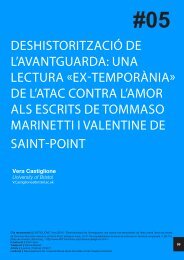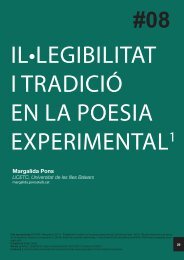03 - 452ºF
03 - 452ºF
03 - 452ºF
Create successful ePaper yourself
Turn your PDF publications into a flip-book with our unique Google optimized e-Paper software.
«The Crazy Cat Lady» as a character reveals a great deal about<br />
the figure of the witch 3 . She lives alone and is always depicted with<br />
at least one cat attached to her body. I use the word «attached»,<br />
because she does not hold the cat; instead it appears to hang from<br />
various parts of her person. However, it is also a misnomer to use<br />
the word «cat», for in nearly every appearance of this character a<br />
multitude of cats are attached to her. A freeze-frame of the 2009-<br />
2010 opening credits shows at least nine cats hanging from «The<br />
Crazy Cat Lady». While the representation of this character plays<br />
with the modern stereotype of a «cat lady», or a spinster woman<br />
who only has cats to give her love, it is also difficult to dismiss this<br />
particular example as representative of the «familiar».<br />
As John Sharpe notes in his Instruments of Darkness: Witchcraft in<br />
Early Modern England, the notion of the familiar is perhaps one of<br />
the most identifiable characteristics associated with the witch. This<br />
familiar, usually in the form of a toad, cat, or dog, was assumed to<br />
be a demonic spirit, capable of performing maleficium on behalf of<br />
the witch (1996: 71). However, it was believed that the familiar was<br />
only willing to conduct the maleficium in exchange for human food—<br />
sometimes in the form of animals such as chickens, but more often<br />
in the form of human blood. As Deborah Willis explains, the familiar<br />
«would suck greedily from the witch’s mark or teat—sometimes<br />
described in great detail as a nipplelike protuberance» (1995: 52).<br />
Therefore, to return to «The Crazy Cat Lady», the cats’ attachment<br />
to her body can be read as familiars merely feeding upon her blood 4 .<br />
This idea is further supported in her representation in «I’ve Grown<br />
a Costume on Your Face», as the warts on her face, often used<br />
as evidence for a witch’s mark, are much more clearly visible in<br />
this episode. As Barbara Rosen explains «This mark […] gradually<br />
becomes the outstanding ‘proof’» of not only the existence of a pact<br />
with the devil but that the accused woman is in fact a witch (1991: 17).<br />
Hence, The Simpsons clearly portrays «the real witch», as portrayed<br />
by «The Crazy Cat Lady», as one that is not only easily identifiable<br />
as a witch to the modern audience but is also grounded in two of the<br />
most important aspects of the Early Modern construction of her—the<br />
familiar and the mark.<br />
However, the representation of «The Crazy Cat Lady» also supports<br />
one of the common explanations posited to account for witch<br />
accusations and why women in particular were the main targets.<br />
One analysis of the surviving Early Modern pamphlets depicting the<br />
witch trials notes that the accused was most often an «economically<br />
marginalized» elderly woman, without the influence of a husband<br />
and with a reputation for «doing ill» (Sharpe, 1996: 63). Her age<br />
becomes a factor as she has probably outlived her husband, if she<br />
had ever married to begin with, and is now unable to support herself<br />
financially. She, hence, becomes a burden on her neighbors, as she<br />
NOTES<br />
3 | The name of «The Crazy<br />
Cat Lady» has been revealed<br />
to be Eleanor Abernathy.<br />
However, this revelation did not<br />
occur until «Springfield Up»<br />
(2007). This is the only episode<br />
in which her true name is used.<br />
4 | This idea of the feeding of<br />
the familiar as indicative of<br />
the maternal, especially as<br />
discussed in Willis’s Malevolent<br />
Nurture, will be explored more<br />
thoroughly in the discussion of<br />
«Easy Bake Coven».<br />
The Simpsons, Gender Roles, and Witchcraft: The Witch in Modern Popular Culture - Sarah Antinora<br />
<strong>452ºF</strong>. #<strong>03</strong> (2010) 115-131.<br />
119










